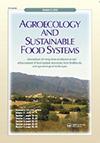Areas and Greenhouse Gas Emissions from Feed Crops Not Used in Canadian Livestock Production in 2001
引用次数: 13
Abstract
Estimates of greenhouse gas (GHG) emissions from Canada's four main livestock industries were integrated with the Canadian Economic and Emissions Model for Agriculture (CEEMA) which operates at the census district level. The livestock crop complex (LCC), which defines the crop area required to feed Canada's livestock, was disaggregated from provincial to district level. The LCC areas were subtracted from the crop areas stored in the CEEMA database to define the maximum area available for non-meat food, fiber, and biofuel feedstock production. The resulting non-livestock residual (NLR) area estimates were 18.7 Mha in the west (excluding rangeland, summerfallow, irrigated cropland and any crops not associated with livestock diets) and 1.0 Mha in the east. The GHG emissions from the NLR in the west were 13.7 Tg CO2e, or 30% of the total GHG emissions from those crops associated with livestock diets. The 1.6 Tg CO2e of GHG from the NLR in Eastern Canada represented 8% of the total GHG emissions from those livestock-related crops. The eastern NLR crop areas were more sensitive to changes in livestock populations than the Western Canada NLR areas because of the more dominant role of livestock production in eastern Canadian agriculture than in the west. The total agricultural GHG emissions budget showed direct but muted sensitivity to changes in Canadian livestock populations in both eastern and Western Canada. The methodology will link agricultural GHG emissions with district level land use decisions.2001年加拿大家畜生产中未使用的饲料作物的面积和温室气体排放
加拿大四个主要畜牧业的温室气体排放估计与在人口普查地区一级运作的加拿大农业经济和排放模型(CEEMA)相结合。家畜作物综合体(LCC)定义了饲养加拿大牲畜所需的作物面积,从省到地区进行了分类。从CEEMA数据库中存储的作物面积中减去LCC面积,以确定可用于非肉类食品、纤维和生物燃料原料生产的最大面积。由此得出的非牲畜剩余面积(NLR)估计在西部为18.7 Mha(不包括牧场、夏耕、灌溉农田和任何与牲畜饲料无关的作物),在东部为1.0 Mha。西部低海拔地区的温室气体排放量为13.7 Tg CO2e,占与牲畜饲料相关的作物温室气体排放总量的30%。加拿大东部NLR产生的1.6 Tg二氧化碳当量温室气体占与畜牧业有关的作物温室气体排放总量的8%。由于畜牧业生产在加拿大东部农业中的主导地位高于西部,因此,加拿大东部野生保护区作物区对牲畜种群变化的敏感性高于加拿大西部野生保护区。农业总温室气体排放预算显示了对加拿大东部和西部牲畜种群变化的直接但微弱的敏感性。该方法将把农业温室气体排放与地区一级的土地利用决策联系起来。
本文章由计算机程序翻译,如有差异,请以英文原文为准。
求助全文
约1分钟内获得全文
求助全文

 求助内容:
求助内容: 应助结果提醒方式:
应助结果提醒方式:


